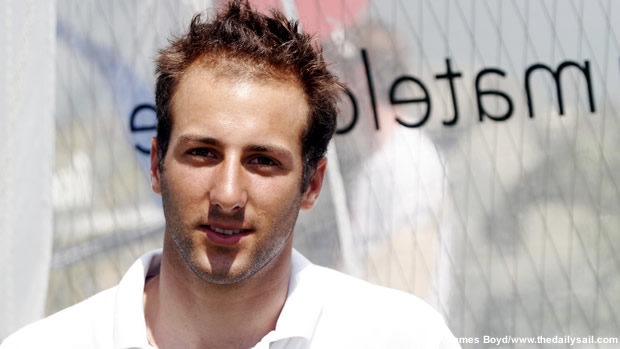
Swiss Moth specialist
Rather quietly Switzerland has over the last few years become one of the hotbeds of innovation in the sailing world, whether it is with foiling 18ft skiffs to the radical boats that race on Lake Geneva such as the extreme Pharos 40 monohulls or the D35 one design catamarans to some of the most profound developments in sail making such as 3DL and 3Di. So it comes as little surprise that the foiling Moth class should be popular on the lake.
Leading exponent of this discipline in Switzerland Geneva is Arnaud Psarofaghis, the reigning European champion, who is currently lying fourth at the Syz & Co Europeans on Lake Silvaplana, near St Moritz, behind Australians Scott Babbage and Nathan Outteridge, and 2009 World Champion from the USA Bora Gulari, but just ahead of reigning World Champion Simon Payne.
Coming from one of the great Swiss sailing families, Psarofaghis, 21, has sailed all his life. The family heralds from Corsier Port about 10 minutes drive northeast from downtown Geneva up towards the French border and they all still live there. Arnaud’s father Francois owns a garage but is an active sailor, but it is uncle Jean who is the best known having run his boatyard for some 35 years.
Jean Psarofaghis with designer Sebastien Schmidt developed the Pharos 40, the most extreme monohull on the lake, complete with canting keel, water ballast and trapezes. To date five have been built. He was also the builder of the Toucan, at one point the most popular one design on the Lake. They have built a range of more conventional, but by normal standards extreme monohulls and multihulls for the lake, the most recent being the Syz & Co foiler cat, which Arnaud sailed on from time to time last year. “It is coming back a lot to the boatyard!” he says. “When it is windy it is a good boat. It is a boat made for straight line sailing and cross winds. It is a bit like L’Hydroptere. It needs 15 knots otherwise it is not working very well.”
Growing up Arnaud sailed dinghies on the lake including the 420 and also the locally popular L’Equipe. He also spent a year campaigning a 49er but says it didn’t work out with the crew, and they stopped. For the last two years he has campaigned one of the popular 28ft M2 catamarans, where a fleet of 22-24 boats now regularly competes. Last year they won the Safram M2 Speed Tour by a country mile aboard Rhône Gestion.
This year Arnaud has graduated up to the D35 class, helming the latest Ylliam of Societe Nautique de Geneve President Pierre-Yves Firminich alongside his father Francois, tactician Jean-Pierre Ziegert and other crew from his winning M2. Ylliam is one of the former Alinghi D35s.
“It is really good,” he says of the D35 circuit. “We only have 12 boats, but the level is really high and it is a really interesting circuit. You can meet a lot of people and the racing is very close and very tactical.”
In terms of his Moth sailing Arnaud says this began in January 2008 with a Bladerider. “Jean-Pierre Ziegert was the first one to have a Moth in Switzerland and I saw him cruising around and it was so easy because he was by himself and he could go out any time he wanted. I tried his boat once and I thought it was awesome. So I tried to get one as soon as possible to go sailing any time I want. I don’t need anyone else.”
But like all the top players in the class has since graduated up to the Andrew McDougall designed McConaghy-built Bladerider development, the Mach 2. A year later in this he won the Europeans.
“I spent a lot of time the first year in the water and we always went out with two or three boats as it is so much easier, because you can line up and see if are going fast or not. We found out when we were with everyone that our speed was really good, so it was a good surprise.”
As to the difference between the Mach 2 and its predecessor, the Bladerider, he says: “It is a much better boat. The boat is much stiffer, the foils particularly the vertical part is way stiffer, but the boat is more difficult to sail. You have to put more energy into the boat. You cannot just sit and cruise. You have to push it hard. The feeling is completely different. You can go faster and all the small details, and the tuning you do with the sails and the foils - you feel it a lot. It has the same controls but because the foils are stiffer you can fly higher and that gives you some more height and more speed. The main foil is the same but I think the rudder slightly bigger. The hull is smaller.”
When it comes to his Moth sailing his targets this year have been the Puma Moth Worlds in Dubai and the current Europeans, squeezing in training around his other sailing.
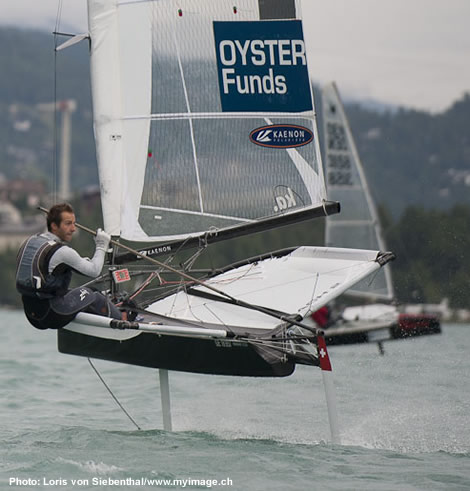
While it sounds like Arnaud is a full time sailor, in fact he has a day job working at North Sails in Switzerland, where he has been for the last four years, starting on the floor and now as a designer.
Innovation is in the Psarofaghis blood and not surprisingly this has extended to his Moth. While all the Mach 2s are essentially one designs, even down to having KA Sails, Arnaud has replaced all the mechanical parts in the wand to lifting foil mechanism with titanium to ensure they are both light and don't break. He was also in early with the ‘ride height adjuster’ a manual tuner on the main lifting foil that is believed to have contributed to Bora Gulari’s World Championship win in 2009.
“I just have a continuous rope. Both ends are tied to the barrel and it goes four or five times around and I just pull a rope block,” he says of his ride height adjuster.
He would like to design his own sail but hasn’t found the time. “I have two North sails, which I struggle a bit to trim and I have an old KA Sail that I love, because it is really easy to trim.”
Since Adam May has been contemplating it for the last months, he says he is also interested in the prospect of building a solid wing sail for his Moth. “But that can be hard to use on the water, to trim it. We’ll see. I would like to try.” One can imagine it being the Psarofaghis family project for this winter.
“We are going to be able to use it for one championship and then it is going to be banned because they want to keep the costs low. Anything you want to do you can do it for one championship and then it will be banned. Otherwise it will be way too complicated – you’ll need a 20ft container to carry one boat. It will be too much.”
At all recent championship Psarofaghis has been at the top of the Moth class, where 10 or 12 individuals are a cut above the rest of the fleet. So what makes the difference? “All the boats are pretty similar. In the top ten we all have the same speed, so it is really hard. For the people out of the top 10 to get into the top 10 they need to be able to go fast all the time with the boat, they need that extra bit of speed. Then it is only about tactics, you make some gains if you tack before the layline and just make it or small details like that that can earn you one more place.”
It is also down to the detail as he explains: “Maybe the difference between half the fleet and the top ones, is before tacking I always ease my vang and Cunningham and I put my ride height adjuster down so that when I come up to tack I can get quicker speed because I know I don’t have that much drag on the water and you come out of the tack quicker and get on to the foils quicker. All these small details, all the top guys do that the back pack don’t and that’s why the gap gets bigger and bigger.”
More work is also possible on the sail he believes, not to make the boat faster but more to get the boat to point higher or sail lower downwind. “Smaller rudder foils - I think that is the future. I doesn’t seem to be slower to take off and as soon as you are up you have less drag and you can go quicker. The smaller we can go with the foils the faster we will go.” Both Andrew McDougall and Scott Babbage were using smaller rudder foils at the Puma Moth Worlds this spring.
“Next year I am going to work a lot on all the drag from the control lines and try and have as less air drag as possible,” he says.
While the gear is all the same, there are still some differences in technique. “AMac and Simon - they point really high upwind, so they can tack early. That is down to time on the water and technique. Also I have been lower downwind than everyone but now everyone has caught up. AMac is the fastest one downwind, he sails much deeper. I think it is his sail trim. He has a really good feel for his boat. He knows when he can go down. On every kind of boat I don’t seem to point that high. So we have different styles of sailing, but we are still really close.”
Whether Psarofaghis can pull it out of the hat at this year’s European championship remains to be seen. With the top end of the fleet now sailing virtually one designs, the difference is now coming down simply to sailing ability and in this respect it is going to be hard to take on the full-time Olympic sailors.

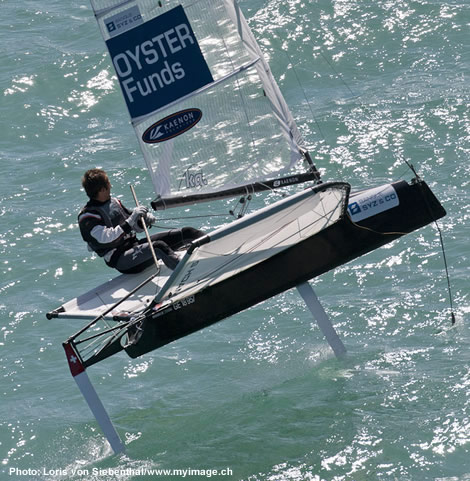
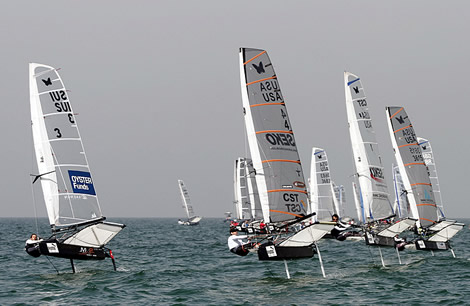
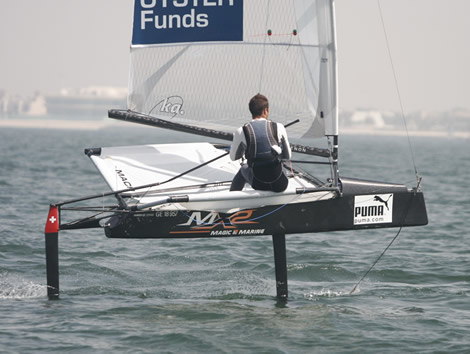








Latest Comments
Add a comment - Members log in